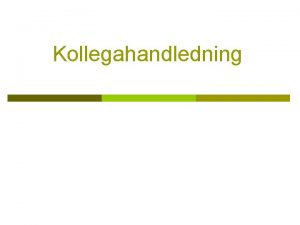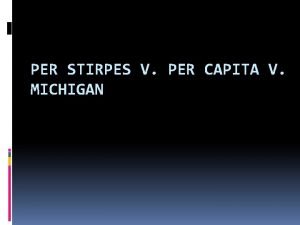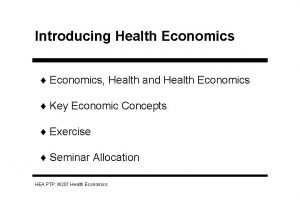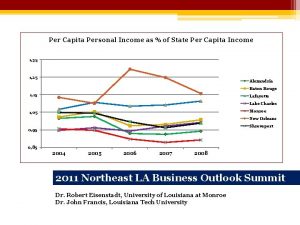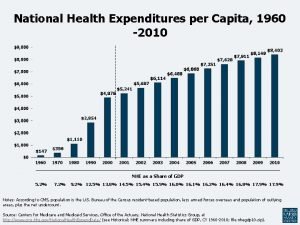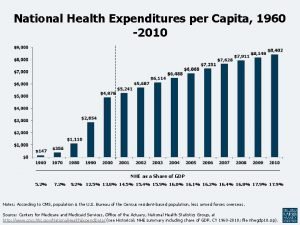Introduction to Health Economics Per Capita Total Current












- Slides: 12

Introduction to Health Economics

Per Capita Total Current Health Care Expenditures, U. S. and Selected Countries, 2007 ^OECD estimate. *Differences in methodology. Notes: Amounts in U. S. $ Purchasing Power Parity, see www. oecd. org/std/ppp; includes only countries over $2, 500. OECD defines Total Current Expenditures on Health as the sum of expenditures on personal health care, preventive and public health services, and health administration and health insurance; it excludes investment. Source: Organisation for Economic Co-operation and Development. OECD Health Data 2009, from the Source. OECD Internet subscription database updated November 2009. Copyright OECD 2009, http: //www. oecd. org/healthdata. Data accessed on 11/13/2009.

National Health Expenditures per Capita and Their Share of Gross Domestic Product, 1960 -2008 5. 2% 7. 2% 9. 1% 12. 3% 13. 5% 13. 6% 14. 3% 15. 1% 15. 6% 15. 7% 15. 8% 15. 9% 16. 2% Source: Centers for Medicare and Medicaid Services, Office of the Actuary, National Health Statistics Group, at http: //www. cms. hhs. gov/National. Health. Expend. Data/ (see Historical; NHE summary including share of GDP, CY 1960 -2008; file nhegdp 08. zip).

National Health Expenditures per Capita, 1990 -2018 Actual Projected $8, 160 (2009) $2, 814 (1990) Source: Centers for Medicare and Medicaid Services, Office of the Actuary, National Health Statistics Group, at http: //www. cms. hhs. gov/National. Health. Expend. Data/ (Historical data from NHE summary including share of GDP, CY 1960 -2007, file nhegdp 07. zip; Projected data from NHE Projections 2008 -2018, Forecast summary and selected tables, file proj 2008. pdf). $13, 100 (2018)

Cumulative Changes in Health Insurance Premiums, Inflation, and Workers’ Earnings, 1999 -2009 Note: Due to a change in methods, the cumulative changes in the average family premium are somewhat different from those reported in previous versions of the Kaiser/HRET Survey of Employer-Sponsored Health Benefits. See the Survey Design and Methods Section for more information, available at http: //www. kff. org/insurance/7936/index. cfm. Source: Kaiser/HRET Survey of Employer-Sponsored Health Benefits, 1999 -2009. Bureau of Labor Statistics, Consumer Price Index, U. S. City Average of Annual Inflation (April to April), 1999 -2009; Bureau of Labor Statistics, Seasonally Adjusted Data from the Current Employment Statistics Survey, 1999 -2009 (April to April).

Federal Programs • Medicare – 100% federal pay – run by the feds – old people, disabled people under SSI • Medicaid – – 1/3 -1/2 cost share by the states - about 25% of LA budget run by states poor people, often old, nursing homes falls apart when folks need it most • Tricare and military health programs – Getting to be big dollars, usually left off the graph

Distribution of Personal Health Care Expenditures by Source of Payment, 1998 and 2008 1998 2008 Public 43. 1% Private 56. 9% Public 46. 5% Private 53. 5% $1. 2 Trillion $2. 3 Trillion Notes: Personal health care expenditures are spending for health care services, excluding administration and net cost of insurance, public health activity, research, and structures and equipment. Out-of-pocket health insurance premiums paid by individuals are not included in Consumer Out-of-Pocket; they are counted as part of Private Health Insurance. Medicaid spending for the State Children's Health Insurance Program (which began in 1998) is included in Other Government Programs, not in Medicaid. Source: Kaiser Family Foundation calculations using NHE data from Centers for Medicare and Medicaid Services, Office of the Actuary, National Health Statistics Group, at http: //www. cms. hhs. gov/National. Health. Expend. Data/ (see Historical; National Health Expenditures by type of service and source of funds, CY 1960 -2008; file nhe 2008. zip).

Medicare Spending as a Share of Total Federal Outlays, FY 2010 Total Outlays = $3. 5 trillion SOURCE: OMB, Fiscal Year 2010 Budget, February 2009. Budget Summary by Category.

Distribution of National Health Expenditures, by Type of Service, 2008 Note: Other Personal Health Care includes, for example, dental and other professional health services, durable medical equipment, etc. Other Health Spending includes, for example, administration and net cost of private health insurance, public health activity, research, and structures and equipment, etc. Source: Kaiser Family Foundation calculations using NHE data from Centers for Medicare and Medicaid Services, Office of the Actuary, National Health Statistics Group, at http: //www. cms. hhs. gov/National. Health. Expend. Data/ (see Historical; National Health Expenditures by type of service and source of funds, CY 1960 -2008; file nhe 2008. zip).

Percent of Total Health Care Spending Concentration of Health Care Spending in the U. S. Population, 2007 (≥$44, 482) (≥$15, 806) (≥$8, 716) (≥$5, 798) (≥$4, 064) (≥$786) (<$786) Note: Dollar amounts in parentheses are the annual expenses person in each percentile. Population is the civilian noninstitutionalized population, including those without any health care spending. Health care spending is total payments from all sources (including direct payments from individuals, private insurance, Medicare, Medicaid, and miscellaneous other sources) to hospitals, physicians, other providers (including dental care), and pharmacies; health insurance premiums are not included. Source: Kaiser Family Foundation calculations using data from U. S. Department of Health and Human Services, Agency for Healthcare Research and Quality, Medical Expenditure Panel Survey (MEPS), 2007.

Distribution of Average Spending Person, 2006 Average Spending Person Age (in years) <5 $1, 508 5 -17 1, 267 18 -24 1, 441 25 -44 2, 305 45 -64 4, 863 >64 8, 776 Sex Male $3, 002 Female 3, 886 Notes: Includes individuals without any spending in 2006. Source: Kaiser Family Foundation calculations using data from U. S. Department of Health and Human Services, Agency for Healthcare Research and Quality, Medical Expenditure Panel Survey (MEPS), 2006.

Putting Off Care Because of Cost In the past 12 months, have you or another family member living in your household… because of the COST, or not? Percent saying “yes” Relied on home remedies or over the counter drugs instead of seeing a doctor Skipped dental care or checkups Put off or postponed getting health care you needed Not filled a prescription for a medicine Skipped recommended medical test or treatment Cut pills in half or skipped doses of medicine Had problems getting mental health care Did ANY of the above Source: Kaiser Family Foundation Health Tracking Poll (conducted November 5 -12, 2009)

